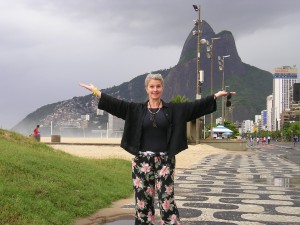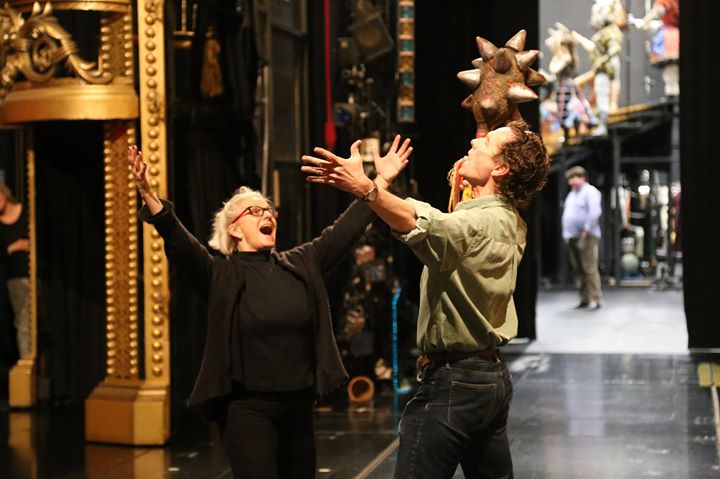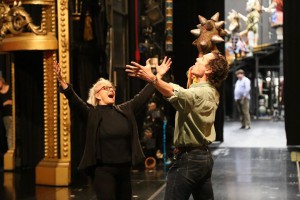Denny Berry is the Production Dance Supervisor/Associate Choreographer of the worldwide production of Phantom. She appeared in the original production of the Broadway show as well has been involved in 14 Phantom productions worldwide. Denny is an Assistant Professor, Head of the Musical Theater Program at the University of Utah.
What was it like being part of the original Broadway production of the show?
I think we all knew the show was special. It had had a spectacular reception in London and the Broadway production was to have the same three West End actors recreating their roles, Michael Crawford, Sarah Brightman and Steve Barton. So there was tremendous excitement about being part of something that we knew was being talked about a great deal. But, no one could know at that time that THE PHANTOM OF THE OPERA was going to break the kinds of records it has come to break. I think most of us thought it was ‘just’ another show. A great show to be sure and we were all excited to be part of it…but no one had any idea that it would have the kind of life and reception it has come to have. It is a wonder even now…hardly believable. I think we all pinch ourselves for the lucky accident to have been touched by this marvelous material spun into gold by the creators and all the magnificent opportunities that have come out of our association with the creators of this great show and the thousands who have become family because of it.
In addition to New York, what is the process of working on PHANTOM productions around the world, both as they debut and as they’re maintained?
Practically speaking, I believe the process is that a local producer will approach our producers (Cameron Mackintosh and The Really Useful Group) and request the rights. Once those hoops have been jumped through, the associate team is nominated and begins the task of organizing the pre-production set up, casting and rehearsal process. Once the show opens the team then is entrusted with the loving care that ensures the show maintains its opening night standards. What a great privilege I have had to travel the world working on this magnificent material… for 28 years!

Do you have specific/favorite memory or anecdote about working on the show?
There are too many to mention. Most have to do with moments that happen in the Kantine or in rehearsal. On the Hamburg revival a few years ago, I worked with John Keuther , whom I first met while working on a co-production of Street Scene at the Houston Grand Opera and Theater Des Westens (Berlin), directed by Francesca Zambello . I introduced John to the “PHANTOM Phamily” and he went on to play in the Swiss Basel production (where he met his wife, who ended up playing Meg), several U.S. Tours , ended up in the Broadway production for many years and we brought him out of hiding again to do the Hamburg production! What a lifetime of wonderful people and paths that have crossed time and again in the course of this production. A gift for those of us who have worked on this marvelous material for 28 years! Childrenhave been born and indeed new generations of our “PHANTOM “Phamily” have been woven tightly together.
Having worked with the show over so many years, are there still any surprises this many years on?
Absolutely! Every single show is unique. Each cast has their own dynamic and their own energy. Every actor who has recreated every role has had a different path to his or her discovery of that role. They each have different strengths and weaknesses. We use those particular details to help them each become the character they need to discover. Every opportunity to help a new actor on that path is different. To be able to recreate the same show to the audience’s eye by getting all these different actors and casts in different languages, in different lands, with different sensibilities is the biggest surprise.
Is it ever intimidating working on such a high profile production?
No, never. At the beginning of this journey, as I have said, it was a show like any other…it was big enough to earn a production in Vienna, and then in Japan and then in Los Angeles and on and on. We, I, had the great privilege to go on and on and grow with this great show. The show didn’t start out where it is now…it grew to be what it has become. For those of us who were there at the start it has become the work of a lifetime. It has become part of who we are, how we breathe and what we love. It is like an appendage or our offspring.
What type of communication language is achieved with movement?
That is a much bigger question than THE PHANOTM OF THE OPERA can answer. Movement is THE language when words cannot express ideas or feelings either because the ideas do not bear articulation or because the language is not something that is shared. We can feel hope, happiness, love, longing, fear and fantasy physically through movement. It embodies the entirety of the feeling. Some folks feel only music can do that, but I feel the physicality that comes through the music and brings it to life – for me at least.
Can you dissect a particular dance segment of the musical?
I can dissect every dance segment of this musical as well as all the staging.
To take the “Degas” Dance sequence in the Rehearsal room that takes place during the dressing room scene:
The girls leave the backstage and wander through the theater on their way to the Dance studio…Once there, Madame Giry shows them a combination (during Meg’s “Where in the world…” lyrics) and they rehearse it (during the String Quartet). Mme. Giry then corrects the girls.
The DSL girl needs to practice her tendue croise port des bras and lengthen her wrist. The DSR girl is working on her 5th position,
When Mme. Giry hears two girls upstage talking, she admonishes them.
Mme. Giry returns so the downstage right girl to examine her 4 count Develop a la Second .
Downstage left needs to lift her chin in a 4 count Penche she is practicing.
Mme. Giry then turns to the second girl stage right to help her with an ecarte develope for 2 counts and 2 counts on to the second girl stage left to get her leg a bit higher in the back develop croise she is working on. The final 4 counts of that phrase has all 4 girls working on their developes together. When Mme. Giry walks downstage through the developes in 2 counts, they all turn around to practice a Penche for 8 counts. Mme. Giry interrupts the penche with her cane to admonish the ballet dancers not to forget about their backs and they chase into tendue/port des bras/backbend to explore their backs.
And this covers only the first section of what has become known as “Degas”!
The detail in choreographer Gillian Lynne’s movement is well-known. And those of us who must pass it on, never, ever forget the beats and the meanings of every count.
Why do you think theatergoers continue to see PHANTOM?
I think, like all good theater, it touches the public. There is so much in the show on so many different levels that one can take from it no matter how involved, how deep one would like to go.
The show is set in a time that never looks dated. If the show is well maintained, the set and props and costumes do not age, certainly the story does not. It is timeless. The show is a spectacular event. Even after 28 years its mechanical elements still do not appear dated. Some shows that have come after PHANTOM may be even more spectacular, but thanks to designer Maria Björnson and director Hal Prince, the show still has integrity and class.
But, spectacle is not the only draw to this work. Andrew Lloyd Webber’s melodies are musical phrases that stick. One leaves the theater (or after hearing the CD) with them in your head…impossible to shake.
The story off a young girl setting out to fulfill her dreams made possible by the Svengali figure who seems to possess her until her lover can retrieve her from the abyss….and then the ultimate rejection of the devoted Svengali by the girl which crushes him. Who has not suffered rejection? Who does not understand desperately wanting something we can never have? It is timeless and terribly human. Audiences are still applauding the Act II opening staircase and weeping for the Phantom crying into Christine’s discarded wedding veil.
What kind of training is necessary for your dancers and how do you suggest they stay in shape while in the show?
The dancers in THE PHANTOM OF THE OPERA are classical ballet dancers. Most of our dancers come from well-known ballet companies. The show requires a classical training and that must be maintained daily to continue to be able to perform as the show demands.
And finally, how many times have you seen the film The Red Shoes, and does it mean something to you?
The Red Shoes…..I can’t count the number of times I have seen the movie. And while the film is intriguing and fun and informative, The Red Shoes that is closer to my heart is the Broadway version, directed by Stanley Donen, choreographed by Lar Lubovitch, in which my husband, Steve Barton (who had just come off a stint of playing the role of The Phantom), played the impresario Lermontov, and Hugh Panaro (who went on to have one of the longest runs of playing the role of The Phantom) plays the young lover. It was an amazing experience for everyone involved in that project and remains dear to my heart.

